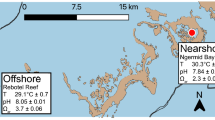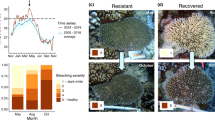Abstract
An organism’s pattern of resource allocation to reproduction and growth over time critically impacts on its lifetime reproductive success. During times of low resource availability, there are two fundamental, mutually exclusive strategies of energy investment: maintenance of somatic tissues to support survival and later reproduction or investment into an immediate reproductive event at the risk of subsequent death. Here, we examine energy allocation patterns in the coral Montipora digitata to determine whether energy investment during periods of resource shortage favours growth or reproduction in a sessile, modular marine species. We manipulated light regimes (two levels of shading) on plots within a shallow reef flat habitat (Orpheus Island, Great Barrier Reef, Australia) and quantified energy uptake (rates of net photosynthesis), energy investment into reproduction (E R ), tissue growth per unit surface area (E T ) and energy channelled into calcification (E C ). With declining resource availability (i.e. reduced photosynthesis), relative energy investment shifted from high (~80%) allocation to tissue growth (E R :E T :E C = 11:81:8%) to an increasing proportion channelled into reproduction and skeletal growth (20:31:49%). At the lowest light regime, calcification was maintained but reproduction was halted and thus energy content per unit surface area of tissue declined, although no mortality was observed. The changing hierarchy in energy allocation among life functions with increasing resource limitation found here for an autotrophic coral, culminating in cessation of reproduction when limitations are severe, stands in contrast to observations from annual plants. However, the strategy may be optimal for maximising fitness components (growth, reproduction and survival) through time in marine modular animals.


Similar content being viewed by others
References
Anthony KRN (1999) Coral suspension feeding on fine particulate matter. J Exp Mar Biol Ecol 232:85–106
Anthony KRN, Connolly SR (2004) Environmental limits to growth: physiological niche boundaries of corals along turbidity-light gradients. Oecologia 141:373–384
Anthony KRN, Fabricius KE (2000) Shifting roles of heterotrophy and autotrophy in coral energetics under varying turbidity. J Exp Mar Biol Ecol 252:221–253
Anthony KRN, Hoegh-Guldberg O (2003) Variation in coral photosynthesis, respiration and growth characteristics in contrasting light microhabitats: an analogue to plants in forest gaps and understoreys? Funct Ecol 17:246–259
Anthony KRN, Connolly SR, Willis BL (2002) Comparative analysis of energy allocation to tissue and skeletal growth in corals. Limnol Oceanogr 47:1417–1429
Bachtiar I (1994) The effect of temperature, photoperiod and fragmentation on the reproduction of mass spawning corals. Master’s thesis. James Cook University, Townsville
Barnes DJ, Chalker BE (1990) Calcification and photosynthesis in reef-building corals and algae, pp. 209–257. In: Dubinsky Z (ed) Coral reefs’ ecosystems of the world. V. 25. Elsevier, New York
Boggs CL (2009) Understanding insect life histories and senescence through a resource allocation lens. Funct Ecol 23:27–37
Buddemeier RW, Kinzie RA (1976) Coral growth. Oceano Mar Biol Ann Rev 14:183–225
Busalmen JP, Roura SI, Roldan H, Crupkin M (1995) Changes in lipids and biochemical properties of actomyosin from pre- and post-spawned hake (Merluccius hubbsi Marini). Comp Biochem Physiol B-Biochem Mol Biol 112:743–748
Calow P (1987) Evolutionary physiological ecology. Cambridge University Press, New York
Chalker BE (1981) Simulating light-saturation curves for photosynthesis and calcification by reef-building corals. Mar Biol 63:135–141
Chalker BE, Dunlap WE, Oliver JK (1983) Bathymetric adaptations of reef-building corals at davies reef, great barrier reef, Australia. II. Light saturation curves for photosynthesis and respiration. J Exp Mar Biol Ecol 73:37–56
Chiariello NR, Gulmon SL (1991) Stress effects on plant reproduction. In: Mooney HA, Winner WE, Pell EJ et al (eds) Response of plants to multiple stresses. Academic Press, San Diego, pp 161–188
Cullen JJ, Lesser MP (1991) Inhibition of photosynthesis by ultraviolet radiation as a function of dose and dosage rate: results for a marine diatom. Mar Biol 111:183–190
DeAngelis DL, Gross LJ (1992) Individual-based models and approaches in ecology. Chapman and Hall, New York
Edmunds PJ (2007) Physiological ecology of the clonal corallimorpharian Corynactis californica. Mar Biol 150:783–796
Edmunds PJ, Spencer Davies P (1986) An energy budget for Porites porites (Scleractinia). Mar Biol 92:339–347
Elendt BP (1989) Effects of starvation on growth, reproduction, survival and biochemical composition of Daphnia pulex. Arch Hydrobiol 116:415–433
Ellers J, van Alphen JJM (1997) Life history evolution in Asobara tabida: plasticity in allocation of fat reserves to survival and reproduction. J Evol Biol 10:771–785
Fischer B, Taborsky B, Dieckmann U (2009) Unexpected patterns of plastic energy allocation in stochastic environments. Am Nat 173:E108–E120
Fischer B, Dieckmann U, Taborsky B (2011) When to store energy in a stochastic environment. Evolution 65:1221–1232
Fisher RA (1930) The genetical theory of natural selection. Oxford University Press, Oxford
Folch J, Lees M, Sloane Stanley GH (1957) A simple method for the isolation and purification of total lipids from animal tissues. J Biol Chem 226:497–509
Goreau TF, Goreau NT (1959) The physiology of skeleton formation in corals. II. Calcium deposition by hermatypic corals under various conditions in the reef. Biol Bull Woods Hole Mass 117:239–250
Grottoli AG, Rodrigues LJ, Palardy JE (2006) Heterotrophic plasticity and resilience in bleached corals. Nature 440:1186–1189
Gutow L, Leidenberger S, Boos K, Franke HD (2007) Differential life history responses of two Idotea species (Crustacea: Isopoda) to food limitation. Mar Ecol Prog Ser 344:159–172
Harland AD, Davies PS, Fixter LM (1992) Lipid content of some caribbean corals in relation to depth and light. Mar Biol 113:357–361
Heyward AJ, Collins JD (1985) Growth and sexual reproduction in the scleractinian coral Montipora digitata (Dana). Aust J Mar Freshw Res 36(3):441–446
Jassby AD, Platt T (1976) Mathematical formulation of the relationship between photosynthesis and light for phytoplankton. Limnol Oceanogr 21:540–547
Kaitala A (1991) Phenotypic plasticity in reproductive behaviour of waterstriders: trade-offs between reproduction and longevity during food stress. Funct Ecol 5:12–18
Kirk JTO (1994) Light and photosynthesis in aquatic ecosystems, 2nd edn. Cambridge University Press, Cambridge
Leuzinger S, Anthony KRN, Willis BL (2003) Reproductive energy investment in corals: scaling with module size. Oecologia 136:524–531
Logan A, Tomascik T (1991) Extension growth rates in two coral species from high-latitude reefs of Bermuda. Coral Reefs 10:155–160
Lough JM, Barnes DJ (1997) Several centuries of variation in skeletal extension, density and calcification in massive porites colonies from the great barrier reef: a proxy for seawater temperature and a background of variability against which to identify unnatural change. J Exp Mar Biol Ecol 211:29–67
Maynard Smith J (1971) The origin and maintenance of sex. In: Williams CG (ed) Group selection. Aldine-Atherton, Chicago, pp 163–171
McCloskey LR, Wethey DS, Porter JW (1978) The measurement and interpretation of photosynthesis and respiration in reef corals. Monogr Oceanogr Methodol (SCOR-UNESCO) 4:379–396
McCloskey LR, Muscatine L, Wilkerson FP (1994) Daily photosynthesis, respiration, and carbon budgets in a tropical marine jellyfish (Mastigias sp.). Mar Biol 119:13–22
Muscatine L (1990) The role of symbiotic algae in carbon and energy flux in reef corals. In: Dubinsky Z (ed) Ecosystems of the world: coral reefs. Elsevier, Amsterdam, pp 75–87
Nespolo RF, Halkett F, Figueroa CC, Plantegenest M, Simon JC (2009) Evolution of trade-offs between sexual and asexual phases and the role of reproductive plasticity in the genetic architecture of aphid life histories. Evolution 63:2402–2412
Noonburg EG, Nisbet RM, McCauley E, Gurney WSC, Murdoch WW, De Roos AM (1998) Experimental testing of dynamic energy budget models. Funct Ecol 12:211–222
R Development Core Team (2007) R: a language and environment for statistical computing. R Foundation for Statistical Computing, Vienna
Reekie EG, Bazzaz FA et al (2005) Reproductive allocation in plants. Elsevier, Amsterdam
Richmond RH (1987) Energetic relationships and biogeographical differences among fecundity, growth, and reproduction in the reef coral pocillopora damicornis. Bull Mar Sc 41:594–604
Riegl B, Branch GM (1995) Effects of sediment on the energy budgets of four scleractinian (Bourne 1900) and five alcyonacean (Lamouroux 1816) corals. J Exp Mar Biol Ecol 186:259–275
Rogers CS (1979) Effect of shading on coral-reef structure, function. J Exp Mar Biol Ecol 41:269–288
Spencer Davies P (1989) Short-term growth measurements of coral growth using an accurate buoyant weighing technique. Mar Biol 101:389–395
Spencer Davies P (1991) Effect of daylight variations on the energy budget of shallow-water corals. Mar Biol 108:137–144
Stearns SC (1989) Trade-offs in life-history evolution. Funct Ecol 3:259–268
Stelzer CP (2001) Resource limitation and reproductive effort in a planktonic rotifer. Ecology 82:2521–2533
Stimson JS (1987) Location, quantity and rates of change in quantity of lipids in tissue of Hawaiian hermatypic corals. Bull Mar Sc 41:889–904
Stobart B (1994) Delimiting coral species using alternative techniques: a case study. Dissertation. James Cook University, Townsville
Stobart B, Babcock RC, Willis BL (1992) Biannual spawning of three species of scleractinian coral from the great barrier reef. In: Proceedings of the 7th international coral reef symposium, vol 1, pp 494–499
Stromgren T (1987) The effect of light on the growth rate of intertidal Acropora pulchra (Brook) from Phuket, Thailand, lat. 8N. Coral Reefs 6:43–47
Tytler EM, Spencer Davies P (1986) The budget of photosynthetically derived energy in the Anemonia-sulcata symbiosis. J Exp Mar Biol Ecol 99:257–270
Velando A, Drummond H, Torres R (2006) Senescent birds redouble reproductive effort when ill: confirmation of the terminal investment hypothesis. P Roy Soc Lond B Bio 273:1443–1448
Ward S, Harrison P (2000) Changes in gametogenesis and fecundity of acroporid corals that were exposed to elevated nitrogen and phosphorus during the ENCORE experiment. J Exp Mar Biol Ecol 246:179–221
Warren CE, Davis GE (1967) Laboratory studies on the feeding, bioenergetics and growth of fish. In: Gerking SD (ed) The biological basis for freshwater fish production. Blackwell Scientific, Oxford, pp 175–214
Wellington GM (1982) An experimental analysis of the effects of light and zooplankton on coral zonation. Oecologia 52:311–320
Williams GC (1966) Natural selection, the cost of reproduction, and a refinement of Lack’s principle. Am Nat 100:687–690
Withers PC (1992) Comparative animal physiology. Saunders College Publishing, Orlando
Yamashiro H, Oku H, Higa H, Chinen I, Sakai K (1999) Composition of lipids, fatty acids and sterols in Okinawan corals. Comp Biochem Physiol B-Biochem Mol Biol 122:397–407
Zera AJ, Harshman LG (2001) The physiology of life history trade-offs in animals. Annu Rev Ecol Syst 32:95–126
Zubay G (1983) Biochemistry, 2nd edn. Addison-Wesley Publishing Company, Reading, Massachusetts
Acknowledgments
We are grateful to Noël Nevers, Sarah Dalesman and Vincent Rivière for assistance in the field and to the staff of Orpheus Island Research Station. The research was supported by grants from the Australian Research Council to K.R.N.A. (A00105071) and to BLW (A 19933007) and a CRC Reef Research Award to S.L.
Author information
Authors and Affiliations
Corresponding author
Additional information
Communicated by R. H. Richmond.
Rights and permissions
About this article
Cite this article
Leuzinger, S., Willis, B.L. & Anthony, K.R.N. Energy allocation in a reef coral under varying resource availability. Mar Biol 159, 177–186 (2012). https://doi.org/10.1007/s00227-011-1797-1
Received:
Accepted:
Published:
Issue Date:
DOI: https://doi.org/10.1007/s00227-011-1797-1




